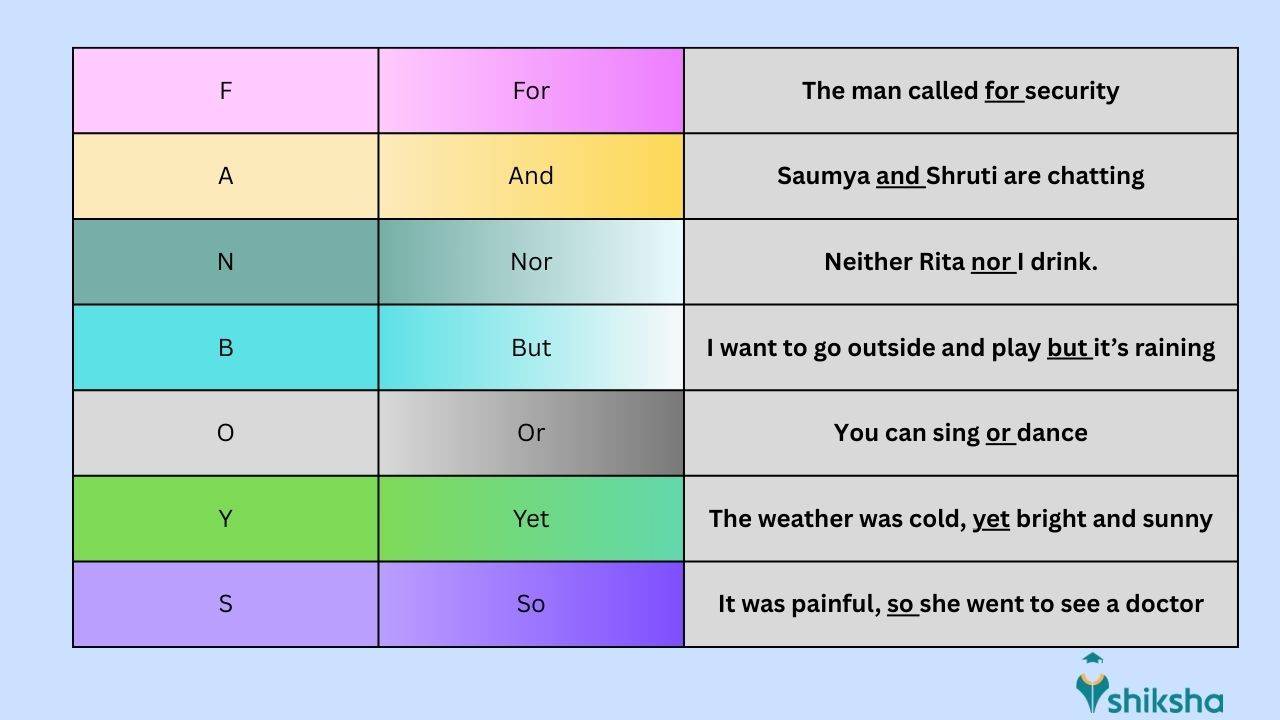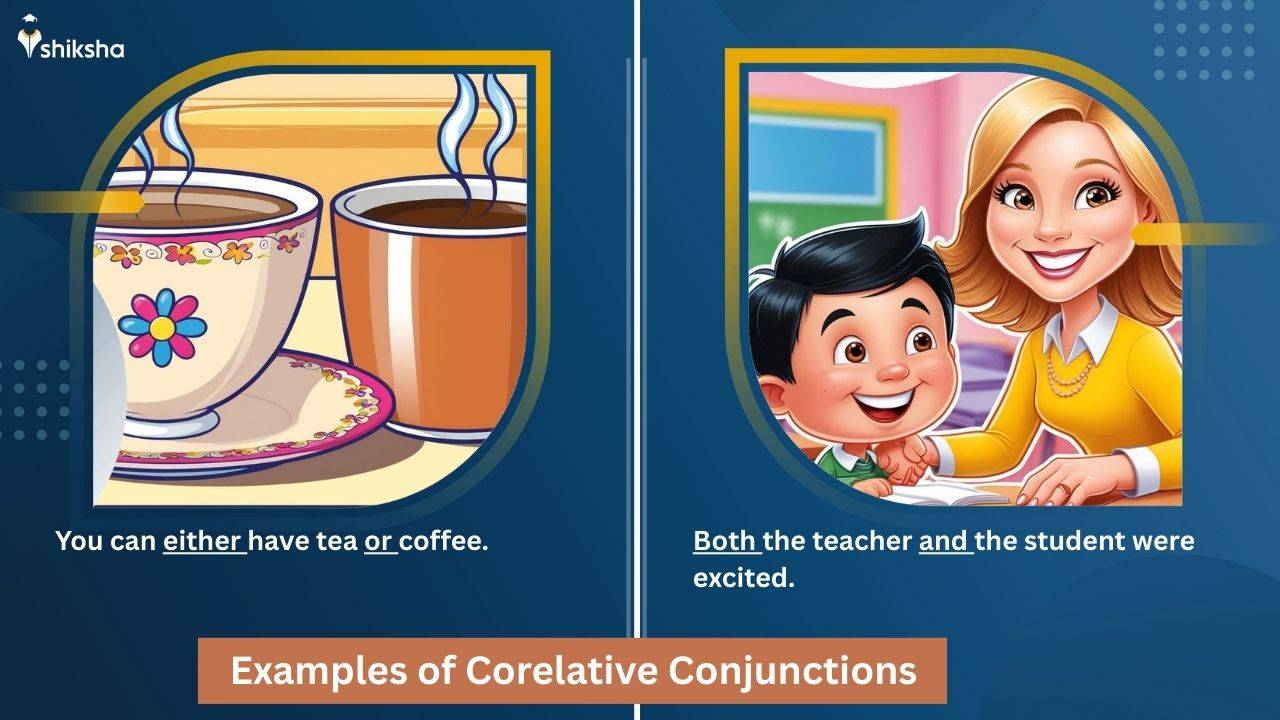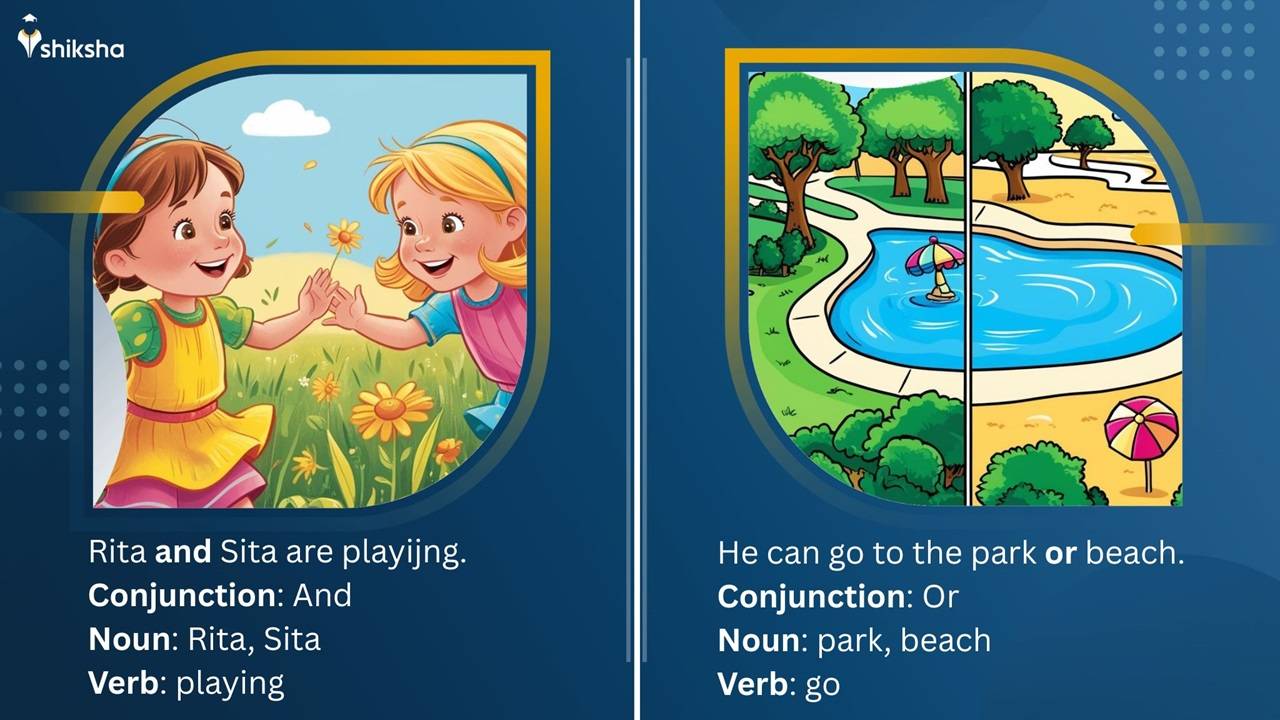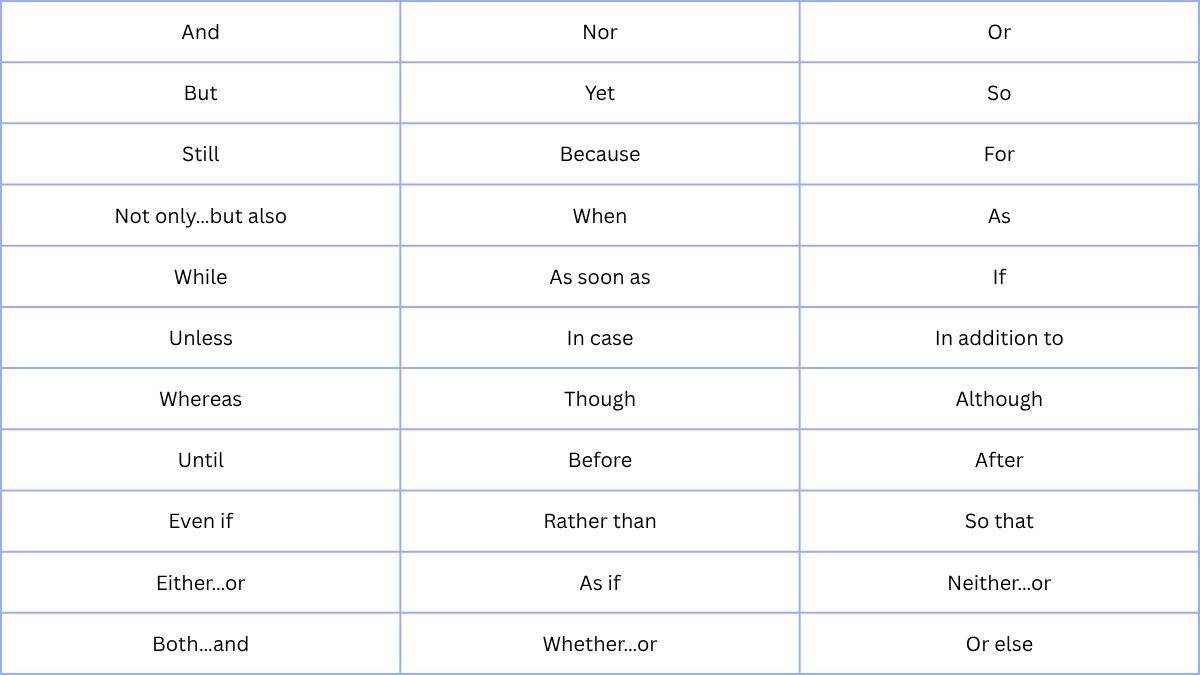
Conjunctions are one of the most important building blocks of English grammar. They help in connecting words, phrases, and clauses to form meaningful sentences. Whether speaking or writing, conjunction words play a key role in expressing ideas clearly and logically. In this page, we will get to know all about conjunctions, their types, function, conjunction examples, exercises with solutions and significance in both written and spoken English.
For example:
- Rita and Sita are playing.
- I like pizza, but I prefer pasta.
In the examples above, ‘and’ and ‘but’ are conjunctions as they connect sentences smoothly.
What are the main types of conjunctions?
Conjunctions are mainly of three types:
- Coordinating conjunctions: and, but, or, nor, for, yet, so
- Subordinating conjunctions: although, because, since, if, when, etc.
- Correlative conjunctions: either.or, neither.nor, not only.but also.
Do we use a comma before a conjunction?
- Yes, we use a comma before a coordinating conjunction when joining two independent clauses.
For example: He was tired, but he kept working.
- No comma is required when the parts are not complete sentences.
For example, He was tired but kept working.
- What is a Conjunction?
- Definition of Conjunctions
- How do Grammar Conjunctions Work?
- Types of Conjunctions in English
- Conjunction Rules in English Grammar
- Importance of Conjunctions in English Grammar
- Special Cases and Exceptions in Conjunctions
- Conjunctions: Difference Between Written and Spoken English
- Common mistakes to avoid in Conjunctions in English
- Types of Conjunctions with Examples
- Preparation Tips to Master Conjunctions
- Best Book to Prepare for Conjunctions
- List of Conjunctions Used in Daily Communication
- Conjunctions Exercises with Answers
- Related English Grammar Topics for Preparation
- FAQs on Conjunctions in English
What is a Conjunction?
Conjunction words are used to connect words, clauses, phrases or sentences. Conjunctions in English grammar are like glue that binds different parts of a sentence together. They are the parts of speech that establish relationships between different ideas or elements in a sentence, such as addition, contrast, cause and effect, or condition. Conjunctions are crucial for creating more complex and meaningful sentences.
In simple terms, a conjunction in English is a word that joins different parts of a sentence, whether it is words, phrases, or clauses. These small but powerful words allow us to communicate our complex thoughts and ideas more simply. Without conjunctions, our communication and writing would be choppy and disconnected, making it hard to convey clear messages. Commonly used conjunctions include:
and, but, or, because, if, when, while, although, yet, so, and for.
Example:
"I want to go for a walk, but it is raining."
Here, "but" connects two contrasting ideas: the desire to go for a walk and the weather condition (raining).
Also Read:
Commonly asked questions
What is the difference between coordinating and subordinating conjunctions?
Coordinating conjunctions join equal parts (e.g., two independent clauses) while Subordinating conjunctions connect a dependent clause to an independent one.
Are linking words and conjunctions the same?
No, not exactly. All conjunctions are linking words, but not all linking words are conjunctions. Words like 'however' or 'therefore' are linking adverbs, not true conjunctions.
Definition of Conjunctions
According to collinsdictionary.com, “any word or group of words, other than a relative pronoun, that connects words, phrases, or clauses; for example and and while” are conjuctions.
According to Oxford dictionary the conjunctions definition is, “a word that joins words, phrases or sentences, for example ‘and’, ‘but’, ‘or’ or ‘because’.
Conjunction Pronunciation: kuhn·juhngk·shnz
How do Grammar Conjunctions Work?
Conjunctions create connections that identify the relationships between ideas or sentence elements. These logical relationships may be used to indicate an addition (as with and), establish cause and effect (because), create contrast (but, yet, although), or introduce a condition (unless), among other things.
Also Read:
Types of Conjunctions in English
Conjunctions come in different forms, each serving a specific purpose in the construction of sentences. The three main types of conjunctions are:
-
Coordinating Conjunctions
Coordinating conjunctions connect words, phrases, or clauses of equal importance. They are used to join elements that are similar in structure or meaning. The most common coordinating conjunctions can be remembered using the acronym FANBOYS (FANBOY Conjunctions):
F - For
A - And
N - Nor
B - But
O - Or
Y - Yet
S - So
Conjunction Examples:
For: He stayed inside, for it was raining heavily.
And: He likes reading, and he enjoys writing.
Nor: She's not the best student in her class, nor is she the worst.
But: I want to go to the school, but it is too cold outside.
Or: Would you like pasta or pizza?
Yet: The weather was beautiful, yet the picnic was a disaster.
So: I was feeling tired, so I decided to take a nap.
-
Subordinating Conjunctions
Subordinating conjunctions connect a subordinate or dependent clause to a main or independent clause. They help to indicate the relationship between the two clauses, such as cause and effect, time, condition or contrast.
Some of the common subordinating conjunctions include:
Since, because, if, although, when, before, while, after, until, unless, whereas, though.
Examples:
- Because: I stayed home because I was feeling sick.
- Although: Although it was raining, they went for a hike.
- If: If you study hard, you will pass the exam.
- When: I will call you when I get home.
-
Correlative Conjunctions
A correlated conjunction is a pair of English conjunctions that work together to combine elements of the same importance. These conjunctions are always shown in pairs, which helps to emphasize the balance of connected ideas.
Some of the common correlation conjunctions:
both...and
either...or
Neither…nor
Not only…but also
Whether…or
Examples:
- Both...and: Both the teacher and the students were excited.
- Either...or: You can either have tea or coffee.
- Neither...nor: She likes neither chocolate nor vanilla.
- Not only...but also: He is not only intelligent, but also very kind.
- Whether...or: Whether you win or lose, you should play fairly.
Conjunction Rules in English Grammar
While using conjunctions is essential for connecting ideas, students must keep in mind certain grammar rules:
- Use of comma: When using coordinating conjunctions to join independent clauses, a comma is often placed before the conjunction (especially in longer sentences).
For example: I wanted to go to the park, but it started raining.
- Subordinate Clauses: If a subordinate (or dependent) clause comes before the main (or independent) clause in a sentence, it's generally followed by a comma to separate it.
Example of conjunction in sentence: Although she was tired, she finished her homework.
- No Comma with Correlative Conjunctions: Correlative conjunctions don’t require a comma between them.
Example: Both the teacher and the students enjoyed the play.
Also Read:
Importance of Conjunctions in English Grammar
Conjunctions in English Grammar are important for many reasons:
- Improving Sentence Structure: Conjunctions enable us to form more complex sentences, which makes our communication more detailed.
- Creating Coherence: They help link ideas logically and smoothly, making writing and speech smoother.
- Add Clarity: By connecting different ideas, conjunctions help clarify the relationship between the ideas.
Read:
Special Cases and Exceptions in Conjunctions
While using conjunctions, we need to keep in mind certain special cases and exceptions as follows:
- Double Conjunctions: Sometimes, a conjunction word in English is used twice for emphasis or clarity.
For example: She not only paints beautiful landscapes, but also sculpts intricate figurines.
Both the students and the teachers were happy with the outcome.
Neither the cat nor the dog wanted to eat the food.
- Omission of Conjunctions: In certain cases, conjunctions can be omitted, especially in informal speech or writing.
Examples of Conjunctions in sentences: She likes tennis; he, basketball.
I came, I saw, I conquered
Meat, potatoes, vegetables, gravy—these make the perfect meal for an omnivore.
Also read about:
Conjunctions: Difference Between Written and Spoken English
Common mistakes to avoid in Conjunctions in English
Types of Conjunctions with Examples
Preparation Tips to Master Conjunctions
Best Book to Prepare for Conjunctions
List of Conjunctions Used in Daily Communication
Conjunctions Exercises with Answers
Related English Grammar Topics for Preparation
FAQs on Conjunctions in English
Commonly asked questions
Can I start a sentence with a conjunction?
Yes, it is acceptable to begin a sentence with conjunctions like "but," "and," or "because," but they should be used sparingly.
What is the purpose of conjunctions?
Conjunctions are used to connect words, phrases, or clauses, allowing us to express more complex and meaningful thoughts in a simpler and smooth way.
Can conjunctions be omitted?
Yes, in informal speech or writing, conjunctions may sometimes be omitted for brevity.
What is the difference between coordinating and subordinating conjunctions?
Coordinating conjunctions connect clauses of equal grammatical weight (e.g., two independent clauses) whereas Subordinating conjunctions (like because, although, while) connect an independent clause to a dependent clause and show the relationship between them (cause, time, contrast, etc.).
Example (Coordinating): He was tired, yet he kept running.
Example (Subordinating): Although he was tired, he kept running.
What are the rules for using commas with conjunctions?
When a conjunction is used to connect two independent clauses, a comma should be used before the conjunction.
To conclude, conjunctions are vital to constructing well-formed sentences in English. Whether writing or speaking, using the right conjunctions will help one convey their message more clearly and effectively.
Conjunctions Exam
Student Forum
Other Topics under this Chapter
Other Class 10th English Chapters
- English Past Tense
- English Idioms
- English Punctuation
- English Analogy
- English Interjections
- English Prefixes
- English Adjectives
- English Future Continuous Tense
- English Letter Writing
- English Suffix
- English Grammar
- English One Word Substitution
- English Mood
- English Direct and Indirect Speech
- English Figures of Speech
- English Composition
- English Para Jumbles
- English Reading Comprehension
- English Sentences
- English Auxiliary and Modal Verbs
- English Formation of Words
- English Precis Writing
- English Nouns
- English Adverbs
- Conjunctions
- English Prepositions
- English Verbs
- English Paraphrasing
- English Articles
- English Subject and Predicate
- English Pronouns
- English Tenses
- English Active and Passive Voice
- English Vocabulary
- English Subject Verb Agreement
- English Phrases
- English Synonyms
- English Etymology and Roots
- English Spelling Rules
- English Parts of Speech
- English Gerunds




